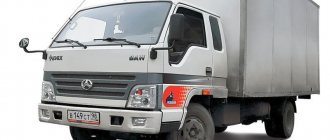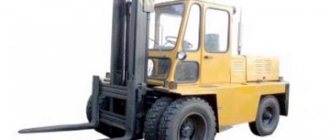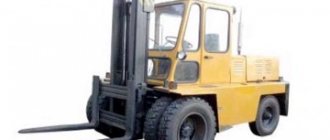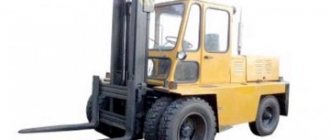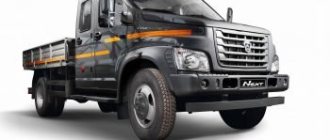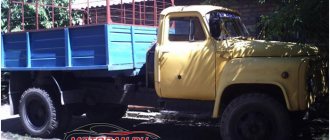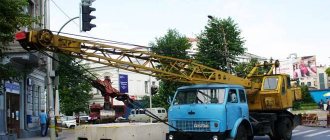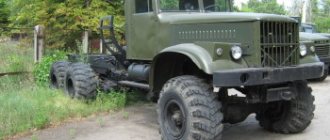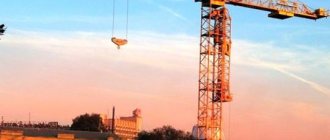Back in the eighties of the last century, active development of a new powerful and at the same time economical gasoline engine began, which was intended for medium-duty vehicles. As a result, a V-shaped eight-cylinder carburetor gasoline engine ZMZ 511 was developed, which has an overhead valve arrangement and blocks with a cylinder camber of 90 degrees.
Thanks to its fairly simple design, this power unit was distinguished by its reliability, ease of maintenance and durability. Provided the ZMZ 511 engine is used correctly, it can cover 200-250 thousand kilometers without major repairs. This engine has excellent fuel efficiency, and due to its technical characteristics it was popular and installed on various medium-duty trucks.
Short description
The ZMZ-511 engine and its modifications are used for installation on medium-duty trucks, such as GAZ-53, GAZ-66, GAZ-3307. ZMZ-511 is a modernized ZMZ-53a, 53-11. The ZMZ-511 uses an untuned single-tier intake manifold, which leads to flow pulsations that negatively affect mixture formation. Cylinder heads with highly turbulent combustion chambers and helical inlet ports are used. These heads provide a compression ratio of 7.6:1, versus 6.7:1 for older engines. The ZMZ-513 engine is a modification of the 511 designed for more difficult operating conditions (for military equipment, for transporting goods in rural areas and in other difficult conditions). The engine has a number of design differences, such as a specially shaped sump for the drive axle, shielded design of electrical components, etc. The power and torque characteristics are the same. The ZMZ-513 engine is distinguished by its heavy weight - 275 kg.
New engine for GAZ 53A
In 1964, the Zavolzhsky Motor Plant, based on the ZMZ 41 engine, developed a new engine that was equipped with the GAZ 53. It should be noted that six-cylinder internal combustion engines were no longer installed on the second generation of “lawns” (GAZ 53A), and in the future only “fifty-thirds” were equipped with V-shaped 8-cylinder engines.
The new internal combustion engine received the ZMZ index 53A. Just like the ZMZ 13, the engine received an aluminum block and two cylinder heads (cylinder heads) made of the same metal. The ZMZ 53A had a number of clear advantages over the outdated six-cylinder internal combustion engine:
- The engine weighed less;
- It had more power and cylinder capacity;
- Fails less often;
- It was more convenient to repair and maintain.
Characteristics of the ZMZ-511/513 GAZ-53, 3307, GAZ-66 engine
| Parameter | Meaning |
| Configuration | V |
| Number of cylinders | 8 |
| Volume, l | 4,254 |
| Cylinder diameter, mm | 92 |
| Piston stroke, mm | 80 |
| Compression ratio | 7,6 |
| Number of valves per cylinder | 2 (1-inlet; 1-outlet) |
| Gas distribution mechanism | OHV |
| Cylinder operating order | 1-5-4-2-6-3-7-8 |
| Rated engine power / at engine speed | 92 kW - (125 hp) / 3400 rpm |
| Maximum torque/at engine speed | 294 N•m / 2000-2500 rpm |
| Supply system | Carburetor K135 |
| Recommended minimum octane number of gasoline | 76 — 80 |
| Environmental standards | Euro 0 |
| Weight, kg | 262 |
Checking the technical condition of the internal combustion engine ZMZ 53
Some indicators can be used to judge the technical condition of the engine. These indicators are:
- oil consumption per 100 (1000) km;
- oil pressure values at idle and medium crankshaft speeds;
- compression in internal combustion engine cylinders.
Oil consumption is checked by level with a dipstick on a cold, unstarted engine. If consumption exceeds 0.4 liters per 100 km, the engine needs to be repaired. But the internal combustion engine can also be repaired with less oil consumption, especially when there are no leaks on the engine.
Oil pressure is controlled by a dial indicator and a warning lamp on the instrument panel. Sometimes sensors are faulty. Accurate readings can be obtained using a control pressure gauge. The minimum pressure at idle speed of the internal combustion engine should not be less than 0.5 kg/cm², at medium speeds this figure should not fall below 1 kg/cm². If the values are lower, the engine is sent for repair.
Compression in internal combustion engine cylinders is measured with a compression meter. This operation must be carried out by two people. Compression is measured with the spark plugs turned out, the throttle valve fully open, on a good battery and the power supply to the high-voltage wires is turned off. Good compression on ZMZ 53 is considered to be 7.5 kg/cm².
Cylinder block
The ZMZ-511 cylinder block is cast from aluminum alloy. Sleeves with bottom fixation are installed on the engines, they are pressed with a head on top, and the sleeves are sealed with copper rings from below. To improve the rigidity of the block, its lower part is located 75 mm below the crankshaft axis.
| Parameter | Meaning |
| Material | Aluminum alloy AL-4 |
| Cylinder diameter, mm | 92,00 |
| Intercylinder distance (distance between the axes of adjacent cylinders of the block), mm | 123,00 |
| Diameter of boring of crankshaft supports (for main bearings), mm | 67,0 |
| Weight, kg | 44 |
The sleeve material is special alloy cast iron. The height of the sleeves is 153 mm. Bore diameter – 100 mm.
Piston
| Parameter | Meaning |
| Diameter, mm | 92,00-91,988 |
| Compression height, mm | 51,0 |
| Weight, g | 565 |
The piston pin has an outer diameter of 25 mm, an inner diameter of 16 mm.
GAZ-3307 cars adopted many technical solutions, components and assemblies from the GAZ-53, including engines, because the modern ZMZ-511 is a direct descendant of the “Gazonovsky” ZMZ-53. Read about GAZ-511 engines, their model range, characteristics, design features and maintenance issues in this article.
Correct engine maintenance
The engine itself is good and does not cause any complaints; the main thing is to maintain its technical condition.
This is what the internal combustion engine looks like for a GAZ 53 car
When carrying out maintenance, the cylinder head must be tightened.
But these are the first three technical inspections, then the frequency can be increased and the cylinder head can be tightened after each TO-2.
Don't forget about the temperature.
To help your engine last longer, replace the piston rings as soon as necessary. The car itself will tell you that it is time to replace the piston rings. In this case, after every 100 km. mileage the oil will decrease by about 400 grams. If the oil pressure in the system has dropped, then the problem is in the crankshaft main bearing shells, which also need to be replaced immediately.
Engine for GAZ 53 cross-section
Characteristics and applicability of ZMZ-511 engines
In 1959, serial production of gasoline 8-cylinder V-shaped engines ZMZ-13 began, which were installed on a number of GAZ vehicles. Already in 1964, deeply modernized ZMZ-53 engines (as well as ZMZ-66) began to be produced, especially widely used in GAZ-53 and GAZ-66 trucks. This series was produced until the early 90s, so 53 and 66 engines are still common.
In the late 1980s, based on the ZMZ-53, power units of the 500 series were developed, among which the ZMZ-511, 513 and 523 “survived” (and are successfully produced) to this day. Motors ZMZ-511 (modernization of the ZMZ-53A, ZMZ-53-11) were and are installed in GAZ-53 and GAZ-3307 trucks, ZMZ-513 (modernization of ZMZ-66-06) - on GAZ-66 trucks, and ZMZ-523 - on GAZ-3307, 3308 and PAZ buses.
Read also: Mazda 323 starter does not turn
The most popular engines today are the ZMZ-511 engines, which are presented in dozens of modifications, but they all have fundamentally the same design and characteristics.
ZMZ-511 is a gasoline carburetor 8-cylinder V-shaped engine with a displacement of 4.254 liters and a power of 125 hp. (at 3500 rpm). Compression ratio - 7.6. According to modern classification, the motor has an environmental class of “Euro-0”. The ZMZ-513 unit has similar characteristics, but it has a reinforced design for operation in more difficult conditions. The weight of the 511th engine is 262 kg, the 513th engine is 275 kg.
ZMZ-511 engines are installed on cars of the GAZ-3307 family, but they have gained some popularity among home-made people. The motor has good boost potential, so it is often modified and installed on trucks, Volga cars and others, as well as on boats and other vehicles.
Information for individuals
How can I pay for the ordered auto parts?
- Cashless payments.
- If it is not possible to transfer funds from the current account, our organization issues an invoice to the individual, which he can pay at any bank.
When can I make payment?
- Full payment upon purchase. NOTE! In this case, the order is sent by any transport company.
- Partial prepayment. Part of the cost of the goods is paid, the rest of the amount is paid after the unit arrives at the terminal of the transport company in your city. NOTE! In this case, the order is sent exclusively by Business Lines.
IMPORTANT! In case of full or partial payment, we will send you by mail a copy of the issued delivery note, certified by a seal, indicating the name of the product and its cost. The original invoice will come with the goods.
Equipment, design and features of the ZMZ-511 motor
Structurally, the power unit is quite simple, which determines its reliability. The engine is based on an aluminum alloy block; two cylinder heads are installed on it (camber angle 90 degrees). At the base of V there is one camshaft, the force from its cams to the valves (installed in the upper part of the heads) is transmitted through rods.
An intake gas pipeline (manifold) is installed between the heads, on which a carburetor, an oil filter and a number of auxiliary components are mounted (crankcase ventilation system, exhaust gas recirculation system, and others). Exhaust manifolds are installed on the outside of the heads.
There is a distributor on top of the engine (it shares a drive from the camshaft with the oil pump). An oil pump (one- or two-section, depending on the modification) is mounted at the rear of the engine, and a water pump integrated with a fan and a generator are mounted at the front. The pump and generator are driven by a V-belt drive from the crankshaft, and the camshaft is driven by a gear drive from the crankshaft.
The main details of the ZMZ-511 engine should be discussed separately.
Cylinder block. The block is cast from aluminum alloy, it also undergoes special treatment and is coated with resin, which ensures tightness. The block contains three stiffening ribs, in which the crankshaft bed is arranged - this is where the main bearings (liners) are located. Also, liners are installed in the front and rear walls of the block. All five crankshaft support points are closed with covers on two bolts. Additionally, at the rear end there is a seal holder, which is closed with a separate cover through gaskets.
The cylinder block contains a water jacket that washes the cylinders. The cylinder liners themselves are of the “wet” type, made of wear-resistant cast iron, they are inserted into the block with the lower part (the shoulder is located here), sealing is achieved by using a copper gasket. This design makes it easy to change sleeves and also ensures effective heat removal from them.
In the rear part, the clutch housing is attached to the block, and the mating surfaces of these parts are processed individually, so installing a housing from another block is impossible without special modifications. The clutch housing and heads are mounted on the block using studs. The oil pan is also mounted using small diameter studs, which are screwed into the bosses provided on the bottom of the block (on the flange).
There are two main types of ZMZ-511 blocks:
- Until 2005, for the installation of a two-section oil pump;
- After 2005 production - for installation of a single-section oil pump.
In terms of their characteristics and design, both blocks are identical; the differences lie only in the configuration of the oil pump installation site.
Crankshaft and piston group. The crankshaft is cast with counterweights, made of high-strength cast iron alloyed with magnesium, with hardened journals on modern versions. The diameter of the main journals is 70 mm, the connecting rod journals are 60 mm. Oil seals are installed in the front and rear parts of the crankshaft, with self-clamping rubber seals in the front and asbestos cord-based seals in the rear. In the rear part, a flywheel is screwed to the shaft with four bolts, in the front part there is a camshaft drive gear (on a key) and a flange for the generator drive pulley and water pump.
The connecting rods are made of steel, they are installed on the shaft through liners (with holes for oil), the connecting rod caps are installed with bolts, which are additionally secured with sealant.
Pistons are cast aluminum alloy. They have a simple flat-bottom configuration, piston diameter is 92 mm (also five repair sizes for overbored liners). The piston has three grooves for installing two compression rings and one oil scraper ring. Installation of the piston on the connecting rod using a steel pin with a diameter of 25 mm. The outer surface of the new piston is coated with tin, which facilitates break-in.
Read also: Starting the engine after a long period of inactivity
Cylinder heads. The engine uses two cast aluminum cylinder heads, they have highly turbulent combustion chambers (provide swirling and good mixing of the fuel-air mixture) and screw channels to the intake valves. Valve seats are plug-in, cast iron. Valve bushings are metal-ceramic. In the upper part of the heads there are valve springs and rocker arms, and the cylinder heads are closed with covers on top.
Fuel system. It is based on a two-chamber K-135 carburetor installed in the upper part of the intake gas pipeline (previously K-126 carburetors were used). Each carburetor chamber supplies a combustible mixture to one row of cylinders. Directly next to the carburetor there is a fine fuel filter. Vacuum is removed from the carburetor to operate the distributor and crankshaft speed limiter. Under the carburetor, in the intake gas pipeline, there is also a vacuum outlet for the operation of the crankcase ventilation system.
Lubrication system. The lubrication system uses a one- or two-section gear oil pump mounted on a block. The pump drive is from the camshaft. Oil is collected from the sump by an oil receiver. Oil cleaning is carried out by a full-flow oil filter installed in the front part of the intake gas pipeline (in front of the carburetor). Previously, a centrifugal filter was used, but today a filter with a replaceable filter element is used. Oil is supplied to the engine components through internal channels, and to and from the filter through metal tubes. An oil cooler can be installed on the engine.
The engine is equipped with protection against oil starvation when the pump jams - if the pump stops, the pin in its drive is cut off, and the entire engine also stops.
Gas distribution mechanism. Built on the basis of a single camshaft located at the base of the block camber. The camshaft drive is gear driven from the crankshaft, the gears are located on the front wall of the block and are covered with a lid. Rods are laid from the camshaft to the heads to drive the rocker arms and valves.
The combustible mixture is supplied from the carburetor to the cylinders through individual channels in the intake gas pipeline. The gas pipeline itself is mounted on the heads using studs through gaskets. The gas pipeline has a simple design, but it is not configured and leads to pulsation of the flow of the combustible mixture; this effect is reduced by the special shape of the combustion chambers and cylinder head inlet channels. Exhaust gases are removed by an exhaust manifold common to the cylinders of the same row. The collector is also mounted with studs through a gasket.
Ignition system. The main system is a distributor (distributor) driven by a camshaft (shared axis with an oil pump). Eight high-voltage wires go from the distributor to the spark plugs screwed into the cylinder head. The distributor is located at the rear of the intake manifold, next to the carburetor.
The current modifications of the ZMZ-511 engine have minor changes and upgrades, but in general their design corresponds to that described above. All this also applies to ZMZ-513 engines; the differences lie in a different configuration of the oil pan, the presence of shielding for the ignition system and some other details.
This design has shown its reliability, so the 500 series motors will probably be produced for a long time without any fundamental changes.
ZMZ-511 motors began to be produced in 1959. The units were widely used on GAZ-53 and -66 vehicles and are still in use today. In the late eighties, new variations of engines of this brand were developed under series No. 500. In principle, these power units have several modifications that are equipped with the same design and parameters, differing in minor aspects.
Lubrication system
The lubrication system uses a single or 2-section gear oil pump mounted on a block. The pump is driven from the camshaft. Oil is collected from the pan by an oil receiver. Oil purification is carried out using a full-flow oil filter installed in the front of the intake manifold, in front of the carburetor. Initially, a centrifugal filter was used here, and in the last years of the model’s production it was replaced by a filter with a replaceable filter element.
General information and consumer reviews
The ZMZ-511 engine is a carburetor V-shaped gasoline engine, which has eight cylinders, has a volume of 4.25 liters, and a power of one hundred and twenty-five horsepower. The power unit complies with the Euro 0 environmental standard, weighs 262 kilograms, and has a speed of three and a half thousand rotations per minute.
As user reviews confirm, the unit has good boosting potential. In this regard, many craftsmen, after modification, install it not only on trucks, but also on Volga-type cars, as well as on boats and other vehicles.
Tuning
The power of the power unit is 92 horsepower at a rotation speed of 3200 rpm.
The engine with a volume of 4.25 liters has a significant reserve for increasing power.
It must be said that even such a major tuning of the ZMZ 511 practically does not change the engine life.
- Some craftsmen, by completely re-sharpening the engine and installing a turbine on it, increase the power to a level of 200 horsepower.
- Changing the operation of the carburetor system is a popular type of tuning. Even one reconfiguration of the carburetor can give an increase of 4-5 horsepower. You just have to understand that such an increase in power is achieved solely by increasing the enrichment of the mixture. As a result, fuel consumption increases, which is often critical when using a vehicle for long-distance transportation of goods.
- The installation of special injectors on the ZMZ 511 engine is very popular, which allows optimizing fuel consumption and improving the behavior of the car at low engine speeds. We recommend using injectors from other GAZ models.
- Using a machined flywheel can provide an additional 3-5 horsepower, depending on the specific flywheel option. You just need to remember that such excessive grooving can lead to a deterioration in the strength of this element, and the engine itself begins to operate unstably under minimal load.
- The use of lightweight pistons and crankshaft allows you to add about ten more horsepower. We only note that such deep tuning is not popular, since these works are characterized by increased complexity, and the effect of ten additional horsepower does not lead to a radical improvement in the behavior of the car. Such deep tuning will be justified in cases where the engine is being overhauled and restored after serious breakdowns.
- Installing a turbine on the ZMZ 511 engine will be the most radical and quite effective way to increase engine power. It is only necessary to correctly determine the characteristics of the turbo systems used, which will increase the power of the power unit without losing the resource of the power unit.
- Keep in mind that tuning the ZMZ 511 using a turbo should be performed by a professional specialist, which will allow you to avoid any problems with the reliability and performance of the engine.
- The power of the ZMZ 511 engine can be increased by installing a modernized exhaust system, which will add about 5-8 more horsepower. The exhaust system used initially suffocates the engine and reduces its power. By cutting out a few cans and installing a direct exhaust, you can increase the engine power, which will invariably affect the dynamics of the car. Just remember that in this case the environmental friendliness and noise levels of the car may deteriorate.
Device and equipment
The simplicity of the ZMZ-511 engine design determines its practicality and reliability. The installation is based on an aluminum block on which a pair of cylinder head with a camber angle of ninety degrees is mounted. The frame houses a camshaft with cams, the force from which is transmitted to the valves through a special rod.
The collector is installed between the heads. It houses a carburetor, an oil filter element and auxiliary components (ventilation system, recirculation unit and other elements). The outer surface of the heads is equipped with intake manifolds. At the top of the engine there is a distributor connected by a common adapter from the oil pump to the camshaft. In the rear compartment of the unit there is the oil pump itself, which is aggregated with the fan and generator, as well as a V-belt drive that interacts with the crankshaft gear.
Read also: Nissan Leaf battery characteristics
Cost of the 3M3-511 engine in 2018 Repair of spare parts
| ZMZ 511 series engine: characteristics, malfunctions and tuning At this stage, the engine undergoes a total disassembly for spare parts in order to determine which parts are damaged, how much damage is caused to the block and crankshaft, the condition of the cylinder heads, piston group and cylinder heads. In order for the engine of a GAZ 53 car to go without major repairs for as long as possible, it is necessary to regularly diagnose malfunctions and maintain the proper condition of the engine, immediately eliminate all problems that relate to wear of engine parts, and also use fuel and engine oil recommended by the manufacturers. |
| Fuel consumption standards for GAZ cars - AutoGRAPH Before changing the lubricant, you need to find out which oil is most suitable for the GAZ 66 engine and in what quantity to fill. Several modifications were created; in the last years of production of the 3307 version of 2008, the truck was equipped with a modernized ZMZ-5231 internal combustion engine. |
Power plant ZMZ-511: technical characteristics
Below are the main parameters of the technical plan of the motor in question in the most popular version:
- Length/width/height – 1.0/1.1/0.8 meters.
- Weight – 262 kilograms.
- The estimated price is from one hundred seventy-five thousand rubles.
- Power - one hundred twenty-five horsepower.
- Volume – 4.25 liters.
- The piston stroke is 80/88 millimeters.
- Fuel type – AI-76 gasoline.
- Power supply: carburetor.
The ZMZ-511 motor block consists of several main parts, each of which we will consider in more detail.
Cylinder assembly
The cylinders are made of aluminum alloy and coated with resin to ensure sealing. The block is equipped with three stiffeners, which include a housing for the crankshaft and main bearings. In addition, inserts are mounted at the rear and front of the system. All crankshaft support points are covered by provided covers, secured with a pair of bolts. There is also an oil seal holder at the end, fenced off with a separate lid and sealing gaskets.
The ZMZ-511 cylinder block is equipped with a liquid jacket that ensures flushing of the unit. Directly working sleeves are made of durable cast iron, the lower part is inserted into the block, additional sealing is ensured by the use of a copper gasket. This scheme makes it possible to quickly replace the sleeves and guarantees effective heat removal from the elements.
In the rear compartment, the clutch housing is attached to the block, the mating surfaces of which are processed individually. In this regard, installation of the crankcase from another similar block is impossible without appropriate modifications. The part is secured using pins. The oil “bath” is installed using an identical small-diameter fastener, which is screwed into special grooves on the flange.
5tudent
Written for everyone who wants to convert the ZMZ-53/66/672/511/513 engine (V=4.25l.) into the PAZ ZMZ-523 engine (V=4.7l.) and maximize its power for minimal money.
A short excursion:
engines ZMZ-53, ZMZ-66, ZMZ-511, ZMZ-513 and ZMZ-672 are almost the same motor. ZMZ-53 is the old designation, the new marking is ZMZ-511. The same thing with ZMZ-66, its new marking is ZMZ-513. The ZMZ-672 motor was created on the basis of the ZMZ-66 and has the same characteristics as the 66th and 53rd. The ZMZ-523 engine was developed in the early 90s - it is an engine of increased displacement, designed for use on PAZ buses and off-road trucks of the GAZ group.
Differences between ZMZ-53/511 and ZMZ-66/513:
This is the 66th
— on the 66/513 there are lugs on the cylinder heads for attaching a standard compressor. Shown by arrows.
The difference between the engines of the 53rd and 66th series, from the PAZ ZMZ-523 motor: - first of all, this is the working volume of the ZMZ-53/66 V = 4.25 liters. for ZMZ-523 V=4.7l. — power (with a cylinder head with a compression ratio of 7.6) for the ZMZ-53/66 125 hp. ZMZ-523 has 130 hp. at 3200 rpm - torque for ZMZ-53/66 294 Nm for ZMZ-523 314 Nm at 2000 rpm - the piston diameter of both engines is the same (92 mm), but the piston itself is different
.
- crankshaft: for ZMZ-53/66 the piston stroke is 80mm, for ZMZ-523 the piston stroke is 88mm. — the liners and connecting rods are the same for both engines, but when reworking the engine, it is better to replace the liners. It doesn't cost much, but we get a new piston. Total:
In essence, reworking an engine is equivalent to its overhaul in terms of the cost of spare parts. For such a modification you will need to buy: - PAZ-3205 crankshaft with liners (ZMZ-5234)
— CPG kit assembly (Sleeve 66-1002020-02; Retaining ring 21-1004022-01; Set of rings 402.1000100; Piston 523.1004015; Piston pin 21-1004020-14), I installed the “Kostroma engine part”
— a set of gaskets and seals, since it is better to replace them when overhauling the engine.
I further increased the engine output by increasing the compression ratio to approximately 8.5. I trimmed the cylinder head by 1.8mm based on the letter from the ZMZ designers, which is available on the Internet. Quote from the letter: “The maximum possible amount of trimming of the cylinder head is 2.2 mm, but in this case you will not be able to fit the intake pipe onto the studs in the cylinder head. You will need 4mm thick side rubber gaskets. Therefore, I recommend that if you decide to trim the head, then no more than 1.8-1.9 mm; in this case, using a needle file, you can still enlarge the holes in the intake pipe for the mounting studs.”
For normal valve adjustment, it was necessary to install valve pusher rods 66-1007175-30, they are shorter.
In the same letter there is another recommendation, I quote: “The ZMZ-513 engine with standard springs and a disabled rev limiter can be spun up to 4300-4500 min-1, at higher speeds the valves “freeze” - the springs do not have time to close them. If you replace the standard springs with stiffer double springs from old ZMZ-402 engines (they must be replaced together with the support washers and spring plates, and the holes in the support washers will have to be enlarged), then it will be possible to spin the engine up to 5000 min-1 or more.”
But since I didn’t plan to spin the engine above 4000 rpm, I didn’t bother with this point. Just as I didn’t install more modern exhaust valves on a thin stem. Standard leg 11mm with sodium filling, modern (valve from ZMZ-402) 9mm without sodium inside. Well, the main point of my “tuning” was the installation of an American carburetor. To do this, I combined the channels in the spider into one and installed the carburetor through a spacer.
It would be ideal, of course, to weld a platform for the carburetor, but I didn’t have that opportunity.
Piston part and crankshaft
The ZMZ-511 motor, the technical characteristics of which can be further improved, is equipped with a cast crankshaft made of high-strength cast iron (with hardened journals and counterweights).
The diameter of the main journals is seventy, the connecting rod elements are sixty millimeters. Oil seals are installed in the front and rear parts of the crankshaft, including a front self-clamping rubber element. The rear similar part is made on the basis of an asbestos cord.
The flywheel is attached to the shaft at the rear with four bolts. At the front there is a camshaft drive gear and flanges for the generator system and water pump. Steel connecting rods are mounted using liners, and the protective covers are additionally treated with sealant. The pistons themselves, with a diameter of 92 millimeters, are made of an aluminum composition, have a simple design with a flat bottom, as well as grooves for installing compression and oil rings. The outer part of the piston is treated with tin, which improves the running-in of the element.
Fuel and lubrication system
With proper maintenance, a major overhaul of the ZMZ-511 may not be required soon, since the motor has a decent service life. The fuel part is based on the K-135 carburetor. It is located in the upper compartment of the intake gas pipeline. Each working chamber supplies the air-fuel mixture to one row of cylinders. The unit is equipped with vacuum outlets for ventilation and conductive passages.
The lubrication system includes a gear oil pump driven by the camshaft. The liquid is purified through a filter, and supplied through an oil receiver. The power unit has protection against lack of oil. If the pump jams, the pin in the drive is cut off and the motor stalls completely.
The ZMZ-511 carburetor engine (the injector is used on experimental models) is equipped with a pair of cast cylinder heads. They are equipped with highly turbulent combustion compartments, as well as helical grooves in relation to the intake valves. The insert seats of the last elements are made of cast iron, the bushings are made of cermet. In the upper part of the cylinder head there are valve springs and rocker arms, which are protected by hinged bolted covers.
Malfunctions
| FAULT | CAUSE |
| The appearance of valve knocking when the speed increases | The reason for this may be the use of low-quality gasoline, which leads to burnout of the valves. Prevention of such problems is the use of high-quality fuel, and repair consists of replacing damaged elements. |
| Insufficient pressure in the lubrication system | The oil deposit has failed, or due to the use of low-quality oil, the channels inside the engine through which the lubricant flows have become dirty. The repair in this case consists of replacing the oil pump and filter. If necessary, all internal oil passages are cleaned. This work is performed using special cleaning oil. |
| Reducing engine thrust | A decrease in engine thrust can occur for various reasons. The weak point of the engine is the deformation of the intake manifold, which occurs on cars with a mileage of more than 300-400 thousand kilometers. Repairing a damaged intake manifold involves replacing it. |
| The appearance of oil leaks in the lower part of the engine | Another weak point of this engine is the rear main bearing. It leaks regularly, resulting in significant oil loss. Repair is hampered by the inaccessible location of the rear main bearing; to replace it, it is necessary to remove all metal engine protection. |
| Oil leaks at the top of the engine | In this case, the problem is standard - it is the cylinder head gasket, which over time becomes dull and begins to leak oil. Repair - replacement of the gasket. At the same time, the condition of the valves is inspected and cleaned. |
| The coolant temperature is regularly increased to maximum | The cause of this problem is the failure of the thermostat and the pump, which is responsible for the movement of coolant in the cooling system. During repairs, the thermostat is initially dismantled, its functionality is checked and, if necessary, it is replaced. Another weak point is the cooling system pump, which must be replaced if broken. |
Ignition
In this system, the main part is the distributor. The mechanism is driven by a camshaft and feeds into several high-voltage cables leading to the spark plugs. The element itself is located in the rear compartment of the intake gas pipeline near the carburetor.
The modernized ZMZ-511 power units, the characteristics of which are indicated above, use an improved oil sump design and shielding of spark plugs. As consumer reviews confirm, in general, the motors in question have proven their reliability and continue to be produced without significant changes compared to the first modifications.
Information for legal entities
The goods are paid for by bank transfer.
How to get an invoice?
You send us your company details by email, we issue an invoice and draw up an agreement. The contract is signed by both parties and after that the client pays the invoice.
How to pay the bill?
Payment by bank transfer to the company's bank account using the details specified in the invoice. All accounting documents are sent along with the goods. Deferred payment is possible (by agreement with management).
All products in our online store have an extended warranty of 6 months (electronics have an extended warranty of 3 months). The warranty card is sent to the buyer along with the spare part.
What it includes:
Guaranteed replacement of spare parts in case of defects within 6 months
If a manufacturing defect is detected, you can exchange the part under warranty within six months after purchase.
For this:
- You must send the part back to us.
- Immediately after receiving the auto parts, we carry out defect detection of the goods (3-10 days).
- If the defect confirms a manufacturing defect, we will send you a new spare part. Our company will cover the shipping costs for sending the replacement part to you.
- If the defect shows that the spare part was damaged as a result of improper use, we can repair it with your consent at your expense. If we refuse to repair, we will send the part back to you. In this case, the transportation costs for sending the part are borne by you.
